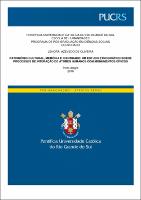| Share record |


|
Please use this identifier to cite or link to this item:
https://tede2.pucrs.br/tede2/handle/tede/8198| Document type: | Tese |
| Title: | Patrimônio cultural, memória e identidade : um estudo etnográfico sobre processos de interação de atores humanos com monumentos cívicos |
| Author: | Oliveira, Lenora Azevedo de  |
| Advisor: | Jungblut, Airton Luiz |
| Abstract (native): | Este trabalho dedica-se ao estudo dos processos de interação com os monumentos cívicos na perspectiva da “constelação identitária” formada pelas categorias patrimônio cultural, memória e identidade. Os monumentos cívicos são construídos com objetivo de consagrar valores considerados caros a um grupo social, normalmente ligados à identidade e à memória, servindo como suporte material para as tradições existentes ou para a construção de novas tradições. Para realizar este estudo adota-se o método etnográfico, cujo objetivo é a compreensão das práticas culturais da contemporaneidade e em que medida essas práticas se modificam desde a construção do monumento, com a realização ou não de outras e diferentes práticas. Três monumentos são escolhidos para esta análise: o Monumento a Júlio de Castilhos, em Porto Alegre, o North Bondi War Memorial e o Anzac Memorial Hyde Park – ambos na cidade de Sydney, na Austrália. O estudo teórico e a pesquisa empírica mostram que as práticas sociais decorrentes das artes de fazer (DE CERTEAU, 2014) que se desenvolvem com estes monumentos podem ou não contribuir para o sentimento de pertencimento a um grupo social, pois são as duas dimensões do patrimônio cultural, a material [monumentos] e a imaterial [rituais e comemorações], que revelam de que maneira se constrói e se mantém a memória e a identidade. Por isto, o ato de lembrar está diretamente vinculado às práticas sociais que, quanto mais emoções incluem em seus processos, maior é a capacidade de lembrar. Neste sentido, os monumentos podem ser “suporte de memória” (NORA, 1993), “suporte de história” ou objetos comuns. Serão “suporte de memória” quando a eles estiver associada a memória viva; serão “suporte de história” quando a eles estiver associada a memória histórica; e serão objetos comuns quando não existir memória sobre eles. Neste último caso, os monumentos podem ser ressignificados e as práticas sociais estarão desvinculadas das suas funções originais. |
| Abstract (english): | This work is a study of human interaction with civic monuments examining the constellation of cultural heritage, memory and identity. Civic monuments are built with the purpose of establishing and maintaining values considered central to a social group, usually linked to identity and memory, serving as material support for existing traditions or for the construction of new traditions. The ethnographic method’s objective is to understand contemporary cultural practices and to determine to what extent these practices have changed since the construction of the monument, with or without the establishment of other and different practices. Three monuments were chosen for this analysis: the Julio de Castilhos Monument in Porto Alegre, Brazil, the war memorial monument at North Bondi and the Anzac Memorial Hyde Park, both in the city of Sydney, Australia. Research has shown that social interactions with monuments can contribute to a feeling of belonging to a social group and the interaction with cultural heritage could build and maintain memory and identity. Research on social practices with the monuments indicates that this may or may not contribute to the feeling of belonging to a social group. Cultural heritage, tangible (monuments) and intangible (rituals), are examined specifically in the way memory and identity are created and maintained. The act of remembering is directly tied to social practices and the more emotions experienced in the social practice the greater the capacity of the individual to remember. Monuments can be as powerful a “memory support” (NORA, 1993) as they can be a “historical support”. They are memory support when associated with living memory. If there is no kind of memory associated with them, monuments can be redefined and social practices will be disconnected from the monument’s original function. |
| Keywords: | Patrimônio Cultural Monumentos Cívicos Memória Etnografia Brasil e Austrália Cultural Heritage Civic Monuments Memory Ethnography Brazil and Australia |
| CNPQ Knowledge Areas: | OUTROS::CIENCIAS SOCIAIS CIENCIAS HUMANAS::ANTROPOLOGIA |
| Language: | por |
| Country: | Brasil |
| Publisher: | Pontifícia Universidade Católica do Rio Grande do Sul |
| Institution Acronym: | PUCRS |
| Department: | Escola de Humanidades |
| Program: | Programa de Pós-Graduação em Ciências Sociais |
| Access type: | Acesso Aberto |
| Fulltext access restriction: | Trabalho não apresenta restrição para publicação |
| URI: | http://tede2.pucrs.br/tede2/handle/tede/8198 |
| Issue Date: | 10-Jan-2018 |
| Appears in Collections: | Programa de Pós-Graduação em Ciências Sociais |
Files in This Item:
| File | Description | Size | Format | |
|---|---|---|---|---|
| TES_LENORA_AZEVEDO_DE_OLIVEIRA_COMPLETO.pdf | LENORA_AZEVEDO_DE_OLIVEIRA_TES | 6.39 MB | Adobe PDF |  Download/Open Preview |
Items in DSpace are protected by copyright, with all rights reserved, unless otherwise indicated.




